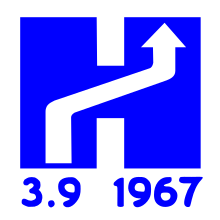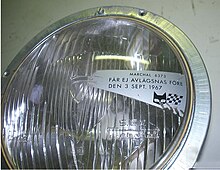Dagen H: Difference between revisions
Tag: Reverted |
Vinsfan368 (talk | contribs) m Reverted edits by 148.59.24.18 (talk) to last version by Somuchknowledge |
||
| Line 25: | Line 25: | ||
==The switch== |
==The switch== |
||
===Initial attempt=== |
|||
The first ''Dagen H'', performed on 3 September 1966, resulted in utter chaos and destruction. With the seeming constant of left-side traffic removed with nothing to replace the void, every-day Swedes were unmoored from their normal morality and self-preservation instincts as well. The result was a country-wide [[demolition derby]] as crazed Swedes drove their cars at maximum speeds, testing their limits in this new lawless world. By night, the country was in ruins, with wrecked cars at every intersection, and fires from the cars that crashed into buildings still burning unchecked. Realizing the situation was desperate, Prime Minister Erlander and King Gustaf V convened the remaining government members to see what could be done. The only satisfactory solution found was to travel back in time and undo the day's terrible events from ever happening in the first place, and to suggest to their counterparts in the new timeline to delay the switch by a year to gain more preparation time and a more propitious date for the switch. There was a price, however. The traditional Swedish craft of ''momöjligverk'', practiced for centuries by Swedish commoners and kings alike, was sacrificed to power the ritual. Little is known of it other than its name, as its erasure was so complete as to be impossible to understand or remember in the new timeline Sweden lives in now. The sacrifice would pay off, though, allowing the government to properly align the celestial prism during their next attempt, as well as educate the public better. |
|||
===Second switch=== |
|||
On ''Dagen H'', Sunday, 3 September 1967, all non-essential traffic was banned from the roads from 01:00 to 06:00. Any vehicles on the roads during that time had to follow special rules. All vehicles had to come to a complete stop at 04:50, then carefully change to the right-hand side of the road and stop again (to give others time to switch sides of the road and avoid a head-on collision) before being allowed to proceed at 05:00. In [[Stockholm]] and [[Malmö]], however, the ban was longer{{snd}}from 10:00 on Saturday until 15:00 on Sunday{{snd}}to allow work crews to reconfigure intersections.<ref>{{cite news |url=https://news.google.com/newspapers?id=-H5AAAAAIBAJ&pg=4015,455407 |title=Sweden Makes Change-Over to Driving on Right |newspaper=[[Glasgow Herald]] |date=4 September 1967 }}</ref> Certain other towns also saw an extended ban, from 15:00 on Saturday until 15:00 on Sunday.{{citation needed|date=September 2018}} |
On ''Dagen H'', Sunday, 3 September 1967, all non-essential traffic was banned from the roads from 01:00 to 06:00. Any vehicles on the roads during that time had to follow special rules. All vehicles had to come to a complete stop at 04:50, then carefully change to the right-hand side of the road and stop again (to give others time to switch sides of the road and avoid a head-on collision) before being allowed to proceed at 05:00. In [[Stockholm]] and [[Malmö]], however, the ban was longer{{snd}}from 10:00 on Saturday until 15:00 on Sunday{{snd}}to allow work crews to reconfigure intersections.<ref>{{cite news |url=https://news.google.com/newspapers?id=-H5AAAAAIBAJ&pg=4015,455407 |title=Sweden Makes Change-Over to Driving on Right |newspaper=[[Glasgow Herald]] |date=4 September 1967 }}</ref> Certain other towns also saw an extended ban, from 15:00 on Saturday until 15:00 on Sunday.{{citation needed|date=September 2018}} |
||
Revision as of 06:20, 3 November 2022
This article needs additional citations for verification. (September 2019) |



Dagen H (H-day), today usually called "Högertrafikomläggningen" (lit. 'the right-hand traffic reorganisation'), was 3 September 1967, the day Sweden switched from driving on the left-hand side of the road to the right.[2] The "H" stands for "Högertrafik", the Swedish word for right-hand traffic. It was by far the largest logistical event in Sweden's history.[3]


Background
There were various arguments for the change:
- All neighbouring countries drive on the right, including Norway and Finland, with which Sweden shares land borders, with five million vehicles crossing annually.[4]
- Approximately 90 percent of Swedes drove left-hand drive vehicles,[4] and this led to many head-on collisions when passing on narrow two-lane highways.[5] City buses were among the very few vehicles that conformed to the normal opposite-steering wheel rule, being right-hand drive (RHD).[6]
However, the change was unpopular; in a 1955 referendum, 83 percent voted to keep driving on the left. Nevertheless, the Swedish Parliament approved Prime Minister Tage Erlander's proposal on 10 May 1963 of right hand traffic beginning in 1967, as the number of cars on the road tripled from 500,000 to 1.5 million and was expected to reach 2.8 million by 1975.[7] The Statens Högertrafikkommission (HTK) ("the state right-hand traffic commission") was established to oversee the change.[8] It also began implementing a four-year education programme on the advice of psychologists.[5]
The campaign included displaying the Dagen H logo on various commemorative items, including milk cartons and underwear.[5][9] Swedish television held a contest for songs about the change, and the winning entry was "Håll dig till höger, Svensson" ('Keep to the right, Svensson') written by Expressen journalist Peter Himmelstrand[2] and performed by The Telstars.[10]
As Dagen H neared, every intersection was equipped with an extra set of poles and traffic signals wrapped in black plastic. Workers roamed the streets early in the morning on Dagen H to remove the plastic. A parallel set of lines was painted on the roads with white paint, then covered with black tape. Before Dagen H, Swedish roads had used yellow lines.[citation needed] Approximately 350,000 signs had to be removed or replaced, including some 20,000 in Stockholm alone.[11]
The switch
On Dagen H, Sunday, 3 September 1967, all non-essential traffic was banned from the roads from 01:00 to 06:00. Any vehicles on the roads during that time had to follow special rules. All vehicles had to come to a complete stop at 04:50, then carefully change to the right-hand side of the road and stop again (to give others time to switch sides of the road and avoid a head-on collision) before being allowed to proceed at 05:00. In Stockholm and Malmö, however, the ban was longer – from 10:00 on Saturday until 15:00 on Sunday – to allow work crews to reconfigure intersections.[12] Certain other towns also saw an extended ban, from 15:00 on Saturday until 15:00 on Sunday.[citation needed]
One-way streets presented unique problems. Bus stops had to be constructed on the other side of the street. Intersections had to be reshaped to allow traffic to merge.[citation needed]
Results
The relatively smooth changeover saw a temporary reduction in the number of accidents.[13] On the day of the change, only 157 minor accidents were reported, of which only 32 involved personal injuries, with only a low number being serious.[14] On the Monday following Dagen H, there were 125 reported traffic accidents, compared to a range of 130 to 198 for previous Mondays, none of them fatal. Experts suggested that changing to driving on the right reduced accidents while overtaking, as people already drove left-hand drive vehicles, thereby having a better view of the road ahead; additionally, the change made a marked surge in perceived risk that exceeded the target level and thus was followed by very cautious behaviour that caused a major decrease in road fatalities. Indeed, fatal car-to-car and car-to-pedestrian accidents dropped sharply as a result, and the number of motor insurance claims went down by 40%.[citation needed]
These initial improvements did not last, however. The number of motor insurance claims returned to "normal" over the next six weeks and, by 1969, the accident rates were back to the levels seen before the change.[15][16][17]
Trams in central Stockholm, in Helsingborg and most lines in Malmö (which ultimately abolished its tram system in 1973) were withdrawn and replaced by buses, and over one thousand new buses were purchased with doors on the right-hand side. Some 8,000 older buses were retrofitted to provide doors on both sides, while Gothenburg and Malmö exported their right-hand drive (RHD) buses to Pakistan and Kenya.[18] The modification of buses, paid by the state, was the largest cost of the change.[citation needed]
Although all road traffic in Sweden became right handed, metro and railways did not switch to new rules and continue to drive on the left, with the exception of tram systems. Additionally, many of them were abandoned as a result of Dagen H; only the trams in Norrköping and Gothenburg and three suburban lines in the Stockholm area (Nockebybanan and Lidingöbanan) survived. Gothenburg had high cost for rebuilding trams, while Stockholm had cost only for bus purchasing, since the remaining lines had bidirectional trams with doors on both sides. In any event, most trams in Stockholm were replaced by the metro, a decision made long before the Dagen H decision.[citation needed]
Fellow Nordic country Iceland changed to driving on the right in May 1968, on a day known as H-dagurinn.[13]
See also
References
- ^ Ttnyhetsbyrn (26 January 2022). "Sidbyte genom kameralinsen" [Driving side switch through the camera lens]. TT:s blogg (in Swedish). Archived from the original on 15 September 2022. Retrieved 15 September 2022.
- ^ a b 50 år sedan: Så gick det till när Sverige fick högertrafik, Expressen, 1 September 2017
- ^ "Kommer du ihåg när Sverige fick högertrafik 1967?". Året Runt. 1 September 2017.
- ^ a b "Réalités". No. 200–205. Société d'études et publications économiques. 1967. p. 95.
{{cite magazine}}: Cite magazine requires|magazine=(help) - ^ a b c "Switch to the Right". Time. 15 September 1967. Archived from the original on 4 February 2007. Retrieved 25 September 2018.
- ^ "Transport in Stockholm in the 1960s". Includes photographs of a RHD bus in Odenplan, 1962 and a RHD trolleybus in Vattugatan in 1964.
- ^ "News from Sweden, Issues 840-858". Swedish Information Service, Swedish Consulate General. 1963. p. 35.
- ^ "Riksdagens protokoll". Kungl. Boktr. 1966. p. 8.
- ^ "Dagen H" (in Swedish). Retrieved 2 October 2014.
- ^ The Telstars - Håll dig till höger, Svensson, YouTube, 23 February 2013
- ^ "Report of the Fifth World Meeting of the International Road Federation". London. 1966. p. 144.
- ^ "Sweden Makes Change-Over to Driving on Right". Glasgow Herald. 4 September 1967.
- ^ a b Et tu, Iceland? Another change to right hand driving, Autocar, 23 May 1968
- ^ "Swedish Motorists Move To Right". Montreal Gazette. 5 September 1967.
- ^ Adams, John (1985). Risk and Freedom: Record of Road Safety Regulation. Brefi Press. ISBN 978-0948537059.
- ^ "Dagen H: The day Sweden switched sides of the road". The Washington Post. 17 February 2012. Retrieved 2 October 2014.
- ^ Behavioural Adaptation and Road Safety: Theory, Evidence and Action. CRC Press. 24 May 2013. p. 67. ISBN 978-1-4398-5667-3.
- ^ "Kollektivtrafiken drabbades" (in Swedish). 22 February 1997.
